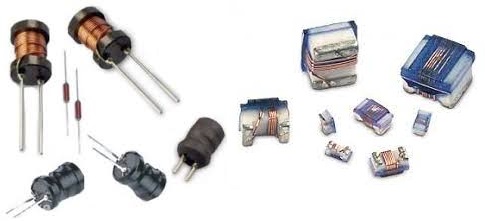The Inductor
 An Inductor is a passive electrical component consisting of a coil of wire which is designed to take advantage of the relationship between magentism and electricity as a result of an electric current passing through the coil. Inductors are made with wire tightly wrapped around a solid central core which can be either a straight cylindrical rod or a continuous loop or ring to concentrate their magnetic flux. An inductor is a component in an electrical circuit which stores energy in its magnetic field. It can release this almost instantly. Being able to store and quickly release energy is a very important feature and that's why we use them in all sorts of circuits.
An Inductor is a passive electrical component consisting of a coil of wire which is designed to take advantage of the relationship between magentism and electricity as a result of an electric current passing through the coil. Inductors are made with wire tightly wrapped around a solid central core which can be either a straight cylindrical rod or a continuous loop or ring to concentrate their magnetic flux. An inductor is a component in an electrical circuit which stores energy in its magnetic field. It can release this almost instantly. Being able to store and quickly release energy is a very important feature and that's why we use them in all sorts of circuits.
An inductor is a passive electronic component that stores energy in the form of a magnetic field when an electric current flows through it. It is typically composed of a coil of wire wound around a core made of ferromagnetic material. The basic principle behind an inductor's operation is electromagnetic induction.
Surface mount (SMD) inductors are placed on the top of a printed circuit board (PCB) on pads with solder paste, and then reflow soldered. Through hole inductors are mounted to the top of a PCB with the leads fed through via holes in the board, and then wave soldered on the backside.
Here are some key characteristics and aspects of inductors:
-
Inductance: Inductance is the fundamental property of an inductor and is a measure of its ability to store magnetic energy. It is denoted by the symbol "L" and is measured in henries (H). The inductance value determines how the inductor responds to changes in current flowing through it. Higher inductance values indicate a greater ability to store energy.
-
Construction: Inductors are typically constructed by winding a conductive wire, usually copper or aluminum, into a coil. The coil may be wound around a core made of different materials, such as iron, ferrite, or air. The core material affects the inductor's inductance, saturation characteristics, and frequency response.
-
Magnetic Field: When an electric current flows through the coil, a magnetic field is created around it. The strength of the magnetic field is proportional to the current flowing through the inductor. As the current changes, the magnetic field changes, and this change induces a voltage across the inductor according to Faraday's law of electromagnetic induction.
-
Energy Storage: Inductors store energy in the magnetic field when a current is flowing through them. When the current through an inductor changes, the energy stored in the magnetic field is released or absorbed. This property allows inductors to oppose changes in current, acting as a kind of "flywheel" that resists rapid changes.
-
Impedance: Inductors exhibit impedance to the flow of alternating current (AC). The impedance of an inductor, denoted by the symbol "Z," depends on its inductance and the frequency of the current passing through it. The impedance of an inductor increases with frequency, causing inductors to resist changes in current more effectively at higher frequencies.
In what applications are inductors used?
Applications: Inductors have numerous applications in electronic circuits. They are commonly used in power supplies, filters, oscillators, transformers, electric motors, and various RF (radio frequency) and communication systems. Inductors are essential components in many electronic devices, helping to control current, filter out noise, and store energy.
Inductors are primarily used in electrical power and electronic devices for these major purposes:
- Choking, blocking, attenuating, or filtering/smoothing high frequency noise in electrical circuits
- Storing and transferring energy in power converters (dc-dc or ac-dc)
- Creating tuned oscillators or LC (inductor / capacitor) "tank" circuits
- Impedance matching
Inductors
offered by IBS Electronics
- API Delevan*
- AEM*
- Cal-Chip*
- Chilisin *
- CoilMaster *
- Etal/Profec*
- Dale*
- Delevan
- Fastron *
- IBS inductors
- IQD
- Gowanda*
- JW Miller
- Johanson Technology
- Mag Layers*
- Renco Electronics
- TDK
- Samwha *
- Siga Transformers*
- Tai-Tech *
- Toko *
- Walsin *
- Yageo*